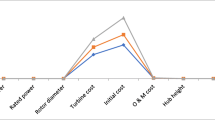Abstract
Solar thermal energy-based electricity is capital-intensive, and complex while technically evolving to achieve an optimal design. Global commitments and timelines to increase renewable energy share in the grid have promoted technically mature solar photovoltaics and wind. However, the potential of solar thermal energy for industrial applications, cogeneration and polygeneration is on the back foot for lack of policy, complexity, technical readiness level, cost of components and workable business models. Solar collectors that can generate high-quality steam for power generation is complex and costly; while, modified version of linear Fresnel reflector’s (LFR) are prospective for various requirements. The current work looks into the possibility of an LFR and heliostat combination to generate steam at 45 bar, 400C temperature to produce electricity. The levelized cost of electricity (LCOE) and levelized cost of water (LCOW) is found to be INR 5.11 kWh−1 and INR 43.03 m−3, in a 70:30 debt–equity scenario. An IRR of 8.55% is achieved with a payback of 12.5 years, with the sale of electricity at INR 10.11 kWh−1 and water at INR 45 m−3. To reduce the LCOE, LCOW and have an attractive IRR, the viability gap funding (VGF) as an option is tried out. The impact of VGF at, 0%, 10%, 20% and 30% on water generation, electricity generation, IRR, NPV and payback are found. It is found that as the VGF increase, there is a better generation cost for electricity and water, with an improved IRR. However, with the VGF trend and corresponding reduction in electricity and water production cost, it will be ideal to have the VGF close to 15% to keep the electricity sale price at approximately INR 8.5 kWh−1 and water pricing at INR 46 m−3.











Similar content being viewed by others
References
Thomas S, Sahoo SS, Ajithkumar G, Thomas S, Auroshis R, Mahapatra RS. Socio-economic and environmental analysis on solar thermal energy-based polygeneration system for rural livelihoods applications on an Island through interventions in the energy-water-food nexus. Energy Convers Manage. 2022;270: 116235. https://doi.org/10.1016/j.enconman.2022.116235.
Pierce W, Gauché P, von Backstrom T, Brent AC, Tadros A. Appl Therm Eng. 2013;61(2):657–62.
Manikumar R, Arasu AV. Distrib Gener Altern Energy J. 2018;33(3):57–80.
Sharma C, Sharma AK, Mullick SC, Kandpal TC. Renew Energy. 2016;87(1):666–7.
Al-Sulaiman FA. Energy Convers Manage. 2014;77:441–9.
Bellos E. Progress in the design and the applications of linear fresnel reflectors—a critical review. Therm Sci Eng Prog. 2019. https://doi.org/10.1016/j.tsep.2019.01.014.
Kasaeian A, Bellos E, Shamaeizadeh A, Tzivanidis C. Appl Energy. 2020;264: 114764.
Bermejo P, Pino FJ, Rosa F. Sol Energy. 2010;84(8):1503–12.
Morin G, Dersch J, Platzer W, Eck M. Häberle Solar Energy. 2012;86(1):1–12.
Singhai R, Sinhmar H, Banker ND. Effect of aspect ratio of heliostat on cost of energy from solar power tower plants. Arab J Sci Eng. 2019;45(2):877–90. https://doi.org/10.1007/s13369-019-04105-0.
ANU, Heliostat Cost Down Scoping Study Final Report, © 2013 ASTRI.
Thomas S, Aithkumar G, Sahoo SS, Varghese S. Int Energy J. 2018;18:243–56.
Barza A, Shourije SR, Pirouzfar V. Industrial optimization of multi-effect desalination equipment for olefin complex. J Therm Anal Calorim. 2020;139:237–49. https://doi.org/10.1007/s10973-019-08279-5.
Panchal S, Dincer I, Agelin-Chaab M. Energy Buildings. 2016;128:900–10.
Al-Ali M, Dincer I. Appl Therm Eng. 2014;71(1):16–23.
Thomas S, Kandaswamy KR, Natarajan KS, Thomas S, Sahoo SS, Kumar AG. Membrane Distillation (MD) as a desalination component in hybrid desalination process combinations for small Island Applications. 2021. https://doi.org/10.21203/rs.3.rs-1523322/v1.
Krishnan N, Raaja J, Ghosh K, Jhaveri O, Palakodeti K, Nair A, Nikhil *. Review of thin film nanocomposite membranes and their applications in desalination. Front Chem. 2022. https://doi.org/10.3389/fchem.2022.781372.
Singh NS. Fundamentals and Innovations in Solar Energy, Energy Systems in Electrical Engineering https://doi.org/10.1007/978-981-33-6456-1_10
Tyagi H. New Research Directions in Solar Energy Technologies, Energy, Environment, and Sustainability, https://doi.org/10.1007/978-981-16-0594-9.
Hammad B, Al-Abel M, Al-Ghandoor A, Al-Sardeah A. Al-Bashir Renew Sust Energy Rev. 2018;82:2218–34.
Bose AS, Sarkar S. India’s e-reverse auctions (2017–2018) for allocating renewable energy capacity: an evaluation. Renew Sustain Energy Rev. 2019;112:762–74. https://doi.org/10.1016/j.rser.2019.06.025.
Chandan S, Ashish S, Kandpal S, Tara *. Solar thermal power generation in India: effect of potential incentives on unit cost of electricity. Int J Sustain Energ. 2015;2015(36):1–16. https://doi.org/10.1080/14786451.2015.1088016.
Author information
Authors and Affiliations
Corresponding author
Additional information
Publisher's Note
Springer Nature remains neutral with regard to jurisdictional claims in published maps and institutional affiliations.
Rights and permissions
Springer Nature or its licensor (e.g. a society or other partner) holds exclusive rights to this article under a publishing agreement with the author(s) or other rightsholder(s); author self-archiving of the accepted manuscript version of this article is solely governed by the terms of such publishing agreement and applicable law.
About this article
Cite this article
Thomas, S.J., Varghese, S.M., Awad, M.M. et al. Solar thermal energy-based electricity and desalination in India: the impact of viability gap funding (VGF) to normalize levelized cost or production. J Therm Anal Calorim (2024). https://doi.org/10.1007/s10973-024-13264-8
Received:
Accepted:
Published:
DOI: https://doi.org/10.1007/s10973-024-13264-8




